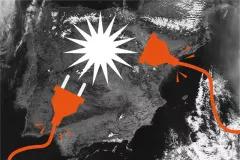The Hambach open-pit mine, widely covered in the news in recent weeks, supplies a significant portion of the coal that is burned in the Niederaussem and Neurath power plants in Germany’s lignite mining area of North Rhine-Westphalia. Its harmful effects on the climate and local environment are well known. Recent analysis by NewClimate Institute has estimated the direct impacts on human health of burning the coal to generate electricity. The pollutants produced by the burning of Hambach coal alone contribute to roughly 320 premature deaths per year, caused for example by heart disease or stroke. Ending coal extraction at Hambach can help put a stop to the avoidable and costly health impacts from burning coal to generate electricity.
How do pollutants affect human health?
The pollutants considered in the analysis include primary particulate matter PM2.5 as well as sulphur dioxide and nitrogen oxides, which produce secondary particulate matter. These micro-particles can reach the blood via the alveoli and in turn negatively impact the cardiovascular system. They can also directly cause respiratory illnesses. The problem is that these diseases are rarely attributed to air pollution. To approximate the damage, our analysis uses methods from epidemiological research, which are also used by the European Commission and the World Health Organization.
What does this mean for the continued discussion around the Hambach forest and the German coal phase-out?
Due to the air pollution from the two power plants, considering only the share of coal sourced from the Hambach open-pit mine, around 320 people lose their life prematurely every year. Almost half of these premature deaths are within Germany. If the plants were to continue operation until 2038, this would mean around 6,440 premature deaths in the coming years. In the case of a shut-down by 2030 the number of premature deaths would fall to approximately 3,860. The analysis does not cover the wider impact of hospital stays, non-fatal illnesses as well as lost working days, which can lead to considerable economic costs.
Interactive graphic on the health impact of the power plants Neurath and Niederaussem:
var divElement = document.getElementById('viz1647275193244'); var vizElement = divElement.getElementsByTagName('object')[0]; vizElement.style.width='650px';vizElement.style.height='627px'; var scriptElement = document.createElement('script'); scriptElement.src = 'https://public.tableau.com/javascripts/api/viz_v1.js'; vizElement.parentNode.insertBefore(scriptElement, vizElement);
Scientific background:
NewClimate Institute’s Health Impact Model is developed under the Ambition to Action (A2A) project. It uses an accessible methodology for quantifying the health impacts of air pollution from different sources of electricity generation and other fuel combustion that can soon be applied in multiple countries in the form of an open source Excel tool. The first version of this tool focuses on electricity generation from coal- and gas-fired power plants. It calculates the impacts on mortality from four adulthood diseases: lung cancer, chronic obstructive pulmonary disease, ischemic heart disease and stroke, all of whose prevalence is increased with the intake of pollution.
The model estimates the pollutant emissions based on plant specific data (location, fuel use, pollutant control technologies, etc,), determines the exposed population with a geographical information system (GIS) software and then calculates the attributed concentration change in PM2.5 levels based on the intake fraction concept and a set of predetermined coefficients. This follows a similar approach to avoid more complex air pollutant dispersion modelling as used by the IMF, amongst others. We then apply cause-specific concentration-response functions which indicate the increase in mortality risk per 10 μg/m³ increase in PM2.5. Combining these risk estimates with age-weighted mortality rates (calculated using regional mortality rates and data on the share of population in different age ranges) and the exposed population the model estimates the number of premature deaths per tonne of pollutant for each cause of death. Finally, we multiply these numbers with the estimated pollutant emissions to obtain the total premature deaths per pollutant and cause for each power plant.





